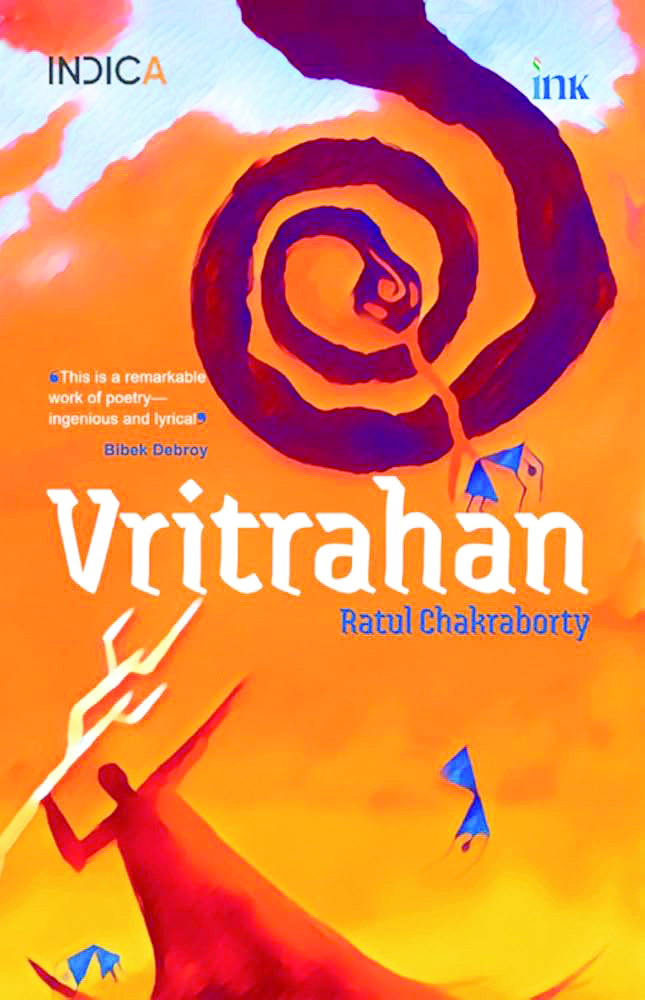Where does one place Ratul Chakraborty’s Vritrahan? As a standalone work of creative imagination, it is remarkable, perhaps even unprecedented in recent times.
Bengaluru: When a book is praised by none other than the late Bibek Debroy as “a remarkable work… transcends the Vritra story”, and when Sanjeev Sanyal calls it “a ‘mad’ project to single-handedly revive the ancient Indian tradition of composing epics”, you know you have a unique book in your hands.
The story of Vritra is an old one. It is found in the first mandala of the Rig Veda, where Vritra is the personification of famine. Most will, however, know Vritra from the Mahabharata, where his account is found in at least two places. The primary narrative is in the Udyoga (thirty-third) and Teertha-Yaatra (forty-ninth) upa parvas, in the Agastya and Indravijaya upakhyaanas, respectively. Furious with Indra for having killed his noble son, Trishiras, Prajapati Tvastha created the fearsome asura, Vritra, and tasked him with defeating and destroying Indra.
Vritra is born from a yagna, from the altar, from the flames of revenge. “The Rageborn. The Restrainer. The Obstacle. Ahi. The Serpent. Vritra. The Dragon.” Much as Ambaa was reborn as Shikhandi, from the inferno of retribution, Vritra was born from the yagna of revenge. Ambaa got her desire; Vritra didn’t. Indra lived, reborn a wiser God. After a brief détente between the two, Indra took advantage of an opportunity and killed Vritra. Sage Dadhichi’s bones became the raw material for a lethal thunderbolt, the Vajra, that Indra wielded to destroy Vritra. This act of killing two Brahmanas, Trishiras and Vritra, led to a sequence of events that saw Indra flee his throne, world order descending into chaos, the rise of adharma, the oceans drying up, Nahusha’s instatement as the new Indra, and eventually to the descent of Ganga on to the earth to restore order, rtá. But that is a tale for another time.
Vritrahan’s narrative strands are held together by a sutradhar, fittingly so. The book is in free verse, and within this framework, Ratul employs different styles and structures in composition. When Tvastha discovers his three-headed son’s corpse, he asks nature, its streams, flowers, the altar, and summons Agni. This passage of several pages itself would make the book a winner, but there is much more. There are reflections on the nature of the cosmic cycle, of the fall and rise of even the king of the Gods. When Tvastha quips that “Dharma is often simple”, the reader may be tempted to view it as a rejoinder to the oft-repeated claim in the Mahabharata, “Dharma is subtle”. Certainly, this was Bheeshma’s response to Draupadi’s pointed poser in the infamous game of dice. Vritra and his army of Kaleyas can be seen as not just as “a reaction to adharma”, but also an “incarnation of avidya”. For this reason, Vritra had to die, and Indra would have to pay the consequences. Gods represented the unfathomable, the infinite. The human mind cannot comprehend the infinite—“Sanity is impossible for the mortal mind.” In the act of making the Gods comprehensible, we also make them human, with human faults and frailties. The story ends with Vritra’s death, followed by a brief epilogue.
Where does one place Ratul’s Vritrahan? First, as a standalone work of creative imagination, it is remarkable, perhaps even unprecedented in recent times. To place it with other works of free verse that are sometimes found on bestseller lists would be an act of artistic heresy, so elevated it is in comparison. Second, as a text that draws on and invites the reader into the world philosophy, of dharma, adharma, karma, vidya, avidya, and the timeless circle of life and death, it again succeeds.
When done well, poetry evokes a sense of wonder at what is implied and the imagery it evokes. The reader is invited to engage in a deeper manner with the text than is often the case with prose. When done well, it can be a profoundly moving experience. On the other hand, doggerel, especially unintentional, or “Instapoetry”, as it is also sometimes called, often represents the nadir of the unwholesome confluence of mediocrity and pretentiousness. Vritrahan is far from mediocre; it is altogether a whole new peak of creativity, ambition, and craft.
In conclusion, this book is stunning in several aspects. For those who read Ratul’s first book, Sutradhar, this may not come as a surprise, given his debut
Disclaimer: views expressed are personal.

